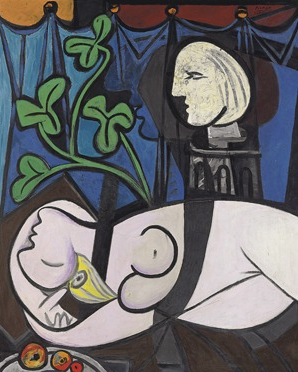The Picasso Sale: World’s Most Expensive Artwork and My Whiskey Chocolate Chili
by Graham T. Beck

Last night, Pablo Picasso’s Nu au Plateau de Sculpteur (1932) fetched more at auction than any artwork in history ($106.5 million!) for the same reason that my whiskey chocolate chili never wins the annual firehouse cook off: popularity, whether measured in US dollars or cayenne-smudged secret ballots, has everything to do with the lowest common denominator.
In this regard, my chili, with its saccharine burn and dyspeptic bite, is unluckily awkward, while Picassso’s five-foot-by-four-foot, painted-in-a-day rendering of Marie-Thérèse Walter, his muse through the 1930s, is deliciously conventional.
She is an outstretched pink blob with the closed eyes and open neck of feminine submission; a vampire’s delight or a voyeur’s wet dream. Perched above this roofied Olympia is her visage again, as a bust in the gray of Grecian stone. Above that and behind it and folded into the blue background is Picasso’s silhouette somehow casting a shadow that rests on top of the pink blob’s breasts and neck in an impressive and impossible fondle. Whew.
As Times art critic Holland Cotter has it:
Nude, Green Leaves and Bust and other paintings from its period are old and easy, art as usual. They keep to the known, the pleasure zone; they keep old orders firm, artist over subject, man over woman, woman as thing, a pink blob with closed eyes.
As they will, some notable art writers disagree with this sweeping assessment of an entire epoch in the career of an artist who is one of the past century’s greatest and most significant, but when it comes to the auction block or the firehouse cookout, the proof isn’t stewing in the pot or penned on the critic’s page but in the dollars paid or the stumpy little fingers of the Napoleonic chief who never calls my name no matter how much salt and cheese I spill into that bubbling pot of ground round.
Though Picasso’s most critically celebrated period-and the one that almost everyone pegs as his most significant contribution to art and culture-is his cubist phase, his most expensive works at market, paintings like Garçon à la pipe (1904), Dora Maar au Chat (1941), Nu au Plateau de Sculpteur and Yo, Picassso (1901) were produced on either side of the cubist window (about 1906–1921, for the nerds following at home). That said, few of those seminal pieces appear at auction or change hands. Arlequin (1909) is the most recent to get near the block. Its estimated sale price in 2008 was a mere (gulp) $30 million, but it was pulled before the sale for private reasons.
I’m certainly not suggesting that only second-tier work sells for exorbitant prices, nor that critical darlings don’t clean up on occasion. But in fine art, like in, well, everything else, critical hits don’t always turn out to be the money-minting endeavors that some middle-of-the road, center of the bell curve, high-testing features turn out to be. That shouldn’t be news to anyone, I guess, just like I’m not completely enraged that last year’s firehouse cook off winner told me his secret ingredients were ketchup and Cheez Whiz. Still, it’s gross.
Graham T. Beck writes about art, cities, the environment and his problems.
